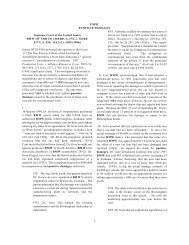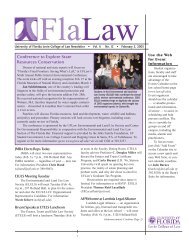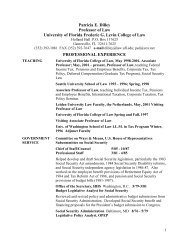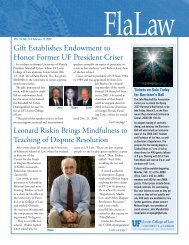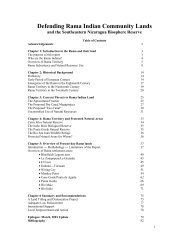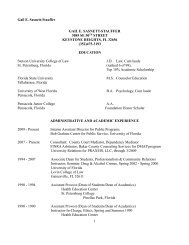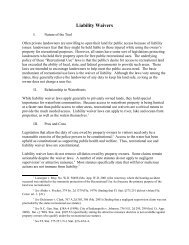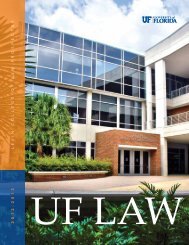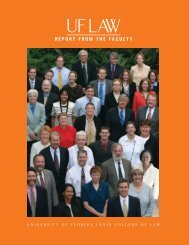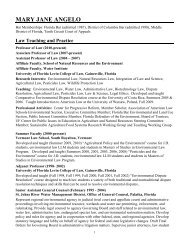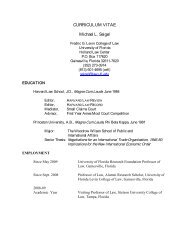Restoration of the Wetlands in Palo Verde National Park: A Legal ...
Restoration of the Wetlands in Palo Verde National Park: A Legal ...
Restoration of the Wetlands in Palo Verde National Park: A Legal ...
Create successful ePaper yourself
Turn your PDF publications into a flip-book with our unique Google optimized e-Paper software.
University <strong>of</strong> Florida<br />
University <strong>of</strong> Costa Rica<br />
Jo<strong>in</strong>t Program <strong>in</strong> Environmental Law<br />
Skills Lab Practicum<br />
<strong>Restoration</strong> <strong>of</strong> <strong>the</strong> <strong>Wetlands</strong> <strong>in</strong> <strong>Palo</strong> <strong>Verde</strong> <strong>National</strong> <strong>Park</strong>: A <strong>Legal</strong> and<br />
Ecological Analysis<br />
F<strong>in</strong>al Report<br />
Students:<br />
Chris Adair- Texas Tech University<br />
Natalia Batista Mora- University <strong>of</strong> Costa Rica<br />
Joelle La<strong>in</strong>g- University <strong>of</strong> Florida<br />
Zach Rogers- University <strong>of</strong> Florida<br />
Faculty advisor: Thomas Ankersen<br />
July 6, 2012
Introduction<br />
Costa Rica's <strong>Palo</strong> <strong>Verde</strong> <strong>National</strong> <strong>Park</strong> (PVNP) is a place worthy <strong>of</strong> protection. It is<br />
located <strong>in</strong> Guanacaste prov<strong>in</strong>ce at <strong>the</strong> term<strong>in</strong>al po<strong>in</strong>t <strong>of</strong> <strong>the</strong> Tempisque- Bebedero watershed<br />
before <strong>the</strong> Tempisque river flows <strong>in</strong>to <strong>the</strong> Gulf <strong>of</strong> Nicoya, and is an <strong>in</strong>tegral element <strong>of</strong> this river<br />
bas<strong>in</strong>. Its borders also conta<strong>in</strong> a wetland ecosystem that provides <strong>the</strong> habitat for a number <strong>of</strong> both<br />
residential and migratory waterfowl (Quesada 2006). Therefore, it is not surpris<strong>in</strong>g that when<br />
Costa Rica ratified <strong>the</strong> Ramsar convention on wetlands <strong>of</strong> <strong>in</strong>ternational importance <strong>in</strong> 1991 <strong>Palo</strong><br />
<strong>Verde</strong> was <strong>in</strong>cluded with<strong>in</strong> <strong>the</strong> Ramsar list. 1<br />
However, significant ecological changes occurr<strong>in</strong>g with<strong>in</strong> <strong>Palo</strong> <strong>Verde</strong> have destroyed a<br />
substantial portion <strong>of</strong> waterfowl habitat <strong>in</strong> recent decades, and caused a significant decrease <strong>in</strong><br />
<strong>the</strong> number <strong>of</strong> birds that nest with<strong>in</strong> it. For at least two centuries previous to <strong>the</strong> designation <strong>of</strong><br />
<strong>Palo</strong> <strong>Verde</strong> as a national park, it had been used for cattle ranch<strong>in</strong>g. In <strong>the</strong> 1920’s this cattle<br />
ranch<strong>in</strong>g <strong>in</strong>tensified, but was stopped suddenly <strong>in</strong> 1980 when <strong>Palo</strong> <strong>Verde</strong> became a national park.<br />
This end to cattle ranch<strong>in</strong>g co<strong>in</strong>cided with an <strong>in</strong>flux <strong>of</strong> cattail that destroyed critical habitat for a<br />
number <strong>of</strong> waterfowl that nested <strong>in</strong> <strong>the</strong> park, dramatically decreas<strong>in</strong>g <strong>the</strong> numbers <strong>of</strong> all<br />
waterfowl that utilized <strong>the</strong> park for nest<strong>in</strong>g, and some previously abundant species actually<br />
disappeared from <strong>the</strong> park completely. <strong>Palo</strong> <strong>Verde</strong> was <strong>the</strong>refore added to <strong>the</strong> Montreux list<br />
with<strong>in</strong> <strong>the</strong> Ramsar convention <strong>in</strong> 1993, designat<strong>in</strong>g it <strong>of</strong>ficially as an impaired ecosystem.<br />
The overarch<strong>in</strong>g objective <strong>of</strong> this policy analysis is to clarify <strong>the</strong> way <strong>in</strong> which <strong>Palo</strong><br />
<strong>Verde</strong> can be removed from <strong>the</strong> Montreux list. This is important for two reasons: First, because<br />
<strong>the</strong> list is an <strong>in</strong>dicator <strong>of</strong> <strong>the</strong> health <strong>of</strong> <strong>the</strong> wetland, and second because hav<strong>in</strong>g a wetland on <strong>the</strong><br />
list is a black mark for Costa Rica. Approach<strong>in</strong>g this objective requires a determ<strong>in</strong>ation <strong>of</strong> (1)<br />
what restoration <strong>of</strong> <strong>Palo</strong> <strong>Verde</strong> will require <strong>in</strong> a scientific sense, (2) what restoration means<br />
with<strong>in</strong> <strong>the</strong> framework <strong>of</strong> <strong>the</strong> RAMSAR convention, (3) how to <strong>in</strong>tegrate <strong>the</strong> domestic law <strong>of</strong><br />
Costa Rica with <strong>the</strong> <strong>in</strong>ternational law <strong>of</strong> RAMSAR, and (4) how to alleviate conflicts with<strong>in</strong> <strong>the</strong><br />
various domestic laws <strong>of</strong> Costa Rica. These goals can <strong>the</strong>n be used to determ<strong>in</strong>e when and how<br />
<strong>the</strong> wetland may be removed from <strong>the</strong> Montreux Record.<br />
Site Description<br />
<strong>Palo</strong> <strong>Verde</strong> <strong>National</strong> <strong>Park</strong> is situated <strong>in</strong> <strong>the</strong> lowlands <strong>of</strong> <strong>the</strong> Tempisque-Bebedero<br />
watershed <strong>in</strong> <strong>the</strong> Guanacaste Prov<strong>in</strong>ce <strong>of</strong> northwest Costa Rica. The natural vegetation <strong>in</strong> <strong>the</strong><br />
watershed is dom<strong>in</strong>ated by tropical dry forest governed by a highly seasonal precipitation<br />
regime. Flows from <strong>the</strong> Tempisque River dra<strong>in</strong> <strong>in</strong>to <strong>the</strong> <strong>Palo</strong> <strong>Verde</strong> wetland, and exit through<br />
1 The specific reasons with<strong>in</strong> <strong>the</strong> RAMSAR convention that <strong>Palo</strong> <strong>Verde</strong> was listed were:<br />
- That it plays a substantial hydrological, biological, or ecological role <strong>in</strong> <strong>the</strong> natural function<strong>in</strong>g <strong>of</strong> a river bas<strong>in</strong> that<br />
it borders<br />
- Is an example <strong>of</strong> a specific type <strong>of</strong> wetland, rare or unusual <strong>in</strong> <strong>the</strong> biogeographic region where it is<br />
- Is <strong>of</strong> special value for ma<strong>in</strong>ta<strong>in</strong><strong>in</strong>g <strong>the</strong> genetic and ecological diversity <strong>of</strong> a region because <strong>of</strong> <strong>the</strong> quality and<br />
peculiarities <strong>of</strong> its flora and fauna<br />
- Is <strong>of</strong> special value as habitat for plants and animals <strong>in</strong> a critical period <strong>of</strong> <strong>the</strong>ir life cycles<br />
- It regularly supports a population <strong>of</strong> 20,000 waterfowl.<br />
Procedure Management Guidance, Report No. 39, Ramsar Site <strong>Palo</strong> <strong>Verde</strong> <strong>National</strong> <strong>Park</strong>, Costa Rica<br />
2
<strong>the</strong> Gulf <strong>of</strong> Nicoya. Prior to 1977, <strong>the</strong> <strong>Palo</strong> <strong>Verde</strong> wetland was privately owned and managed as<br />
an hacienda, and <strong>the</strong> dom<strong>in</strong>ant land use <strong>in</strong> <strong>the</strong> Tempisque Bas<strong>in</strong> was also pasture, with moderate<br />
agricultural production and forested land.<br />
Historical Changes <strong>in</strong> <strong>Palo</strong> <strong>Verde</strong> <strong>National</strong> <strong>Park</strong><br />
The late 1900’s was a period <strong>of</strong> significant local and landscape-level changes <strong>in</strong> <strong>the</strong><br />
Tempisque watershed, and <strong>in</strong> <strong>the</strong> <strong>Palo</strong> <strong>Verde</strong> wetland. In 1980 <strong>Palo</strong> <strong>Verde</strong> was converted to a<br />
<strong>National</strong> <strong>Park</strong>, and cattle graz<strong>in</strong>g, which may have historically contributed to habitat<br />
heterogeneity, was elim<strong>in</strong>ated from <strong>the</strong> wetland. The years follow<strong>in</strong>g <strong>Palo</strong> <strong>Verde</strong>’s designation<br />
as a national park were marked by extensive drought <strong>in</strong> <strong>the</strong> Guanacaste region. In <strong>the</strong> park, <strong>the</strong><br />
effects <strong>of</strong> this ten-year drought were compounded by <strong>the</strong> construction <strong>of</strong> a road to Puerto<br />
Chamorro, which impeded <strong>the</strong> flow <strong>of</strong> Quebrada Huerton from enter<strong>in</strong>g <strong>the</strong> <strong>Palo</strong> <strong>Verde</strong> wetland.<br />
This ephemeral creek was historically important for ma<strong>in</strong>ta<strong>in</strong><strong>in</strong>g higher water levels and<br />
extend<strong>in</strong>g <strong>the</strong> duration <strong>of</strong> <strong>the</strong> wet season <strong>in</strong> <strong>the</strong> wetland 2 . With altered hydrology and little<br />
ra<strong>in</strong>fall, severe forest fires swept through <strong>the</strong> park, caus<strong>in</strong>g changes <strong>in</strong> canopy composition <strong>in</strong> <strong>the</strong><br />
dry forest and decreased species diversity <strong>in</strong> <strong>the</strong> wetland. Typha domignesis (cattail), a species<br />
which responded more positively to <strong>the</strong> altered conditions than many <strong>of</strong> <strong>the</strong> o<strong>the</strong>r native species,<br />
began to spread throughout <strong>the</strong> wetland 3 .<br />
Outside <strong>of</strong> <strong>Palo</strong> <strong>Verde</strong> <strong>National</strong> <strong>Park</strong>, major landscape-scale changes were affront <strong>in</strong> <strong>the</strong><br />
Tempisque River bas<strong>in</strong>. El Proyecto Riego Arenal-Tempisque (PRAT), sponsored by <strong>the</strong><br />
Interamerican Development Bank, enabled <strong>in</strong>tensive rice and sugarcane production <strong>in</strong> <strong>the</strong><br />
sou<strong>the</strong>rn reaches <strong>of</strong> <strong>the</strong> Tempisque Bas<strong>in</strong> though <strong>the</strong> construction <strong>of</strong> 234 km <strong>of</strong> irrigation canals 4 .<br />
As a result <strong>of</strong> <strong>the</strong> new <strong>in</strong>frastructure, a higher percentage <strong>of</strong> land <strong>in</strong> <strong>the</strong> TB was placed <strong>in</strong><br />
agricultural production and a percentage <strong>of</strong> flows which would normally reach <strong>the</strong> <strong>Palo</strong> <strong>Verde</strong><br />
wetland were <strong>in</strong>stead used to irrigate rice and sugarcane fields. Although little data are available,<br />
<strong>the</strong> change <strong>in</strong> land use likely <strong>in</strong>stigated a decl<strong>in</strong>e <strong>in</strong> water quality, <strong>in</strong>clud<strong>in</strong>g potential <strong>in</strong>creases <strong>in</strong><br />
pesticide and nutrient levels and changes <strong>in</strong> sal<strong>in</strong>ity and dissolved oxygen.<br />
Current Ecological Status <strong>of</strong> <strong>Palo</strong> <strong>Verde</strong> <strong>National</strong> <strong>Park</strong><br />
All <strong>of</strong> <strong>the</strong>se changes <strong>in</strong> both <strong>Palo</strong> <strong>Verde</strong> <strong>National</strong> <strong>Park</strong>, and <strong>in</strong> its contribut<strong>in</strong>g watershed, have<br />
resulted <strong>in</strong> major ecological consequences. Though <strong>Palo</strong> <strong>Verde</strong> was historically important for<br />
over 60 species <strong>of</strong> birds, only about half <strong>of</strong> <strong>the</strong>se species are now found <strong>in</strong> <strong>the</strong> wetland <strong>in</strong> <strong>the</strong><br />
2<br />
Recomendaciones Tecnicas para la Restauracion Hidrologica del Parque Nacional <strong>Palo</strong> <strong>Verde</strong>, 49. Organizacion<br />
para Esudios Tropicales.<br />
3<br />
Vaughan, C; McCoy, M.; Fallas, J.; Chaves, H.; Barboza, G; Wong, G.; Carbonell, M. Plan de Manejo y<br />
Desarrollo del Parque Nacional <strong>Palo</strong> <strong>Verde</strong> y Reserva Biologica Lomas Barbudal, Contrato SSENARA-BID-<br />
MINAE-UNA (1996).<br />
4<br />
Daniels, E. Protected area management <strong>in</strong> <strong>the</strong> watershed context: A case study <strong>of</strong> <strong>Palo</strong> <strong>Verde</strong> <strong>National</strong> <strong>Park</strong>, Costa<br />
Rica, 49. Masters Thesis, University <strong>of</strong> Florida (2004).<br />
3
absence <strong>of</strong> active management 5 . Managers and scientists have attributed this decl<strong>in</strong>e to <strong>the</strong><br />
spread and subsequent dom<strong>in</strong>ance <strong>of</strong> Typha, which has reduced <strong>the</strong> number <strong>of</strong> espejos de agua,<br />
or open pools <strong>of</strong> water, <strong>in</strong> <strong>the</strong> wetland and has decreased habitat heterogeneity and plant species<br />
diversity. Without active management, Typha covers approximately 95% <strong>of</strong> <strong>the</strong> <strong>Palo</strong> <strong>Verde</strong><br />
wetland 6 .<br />
General <strong>in</strong>fo about Ramsar<br />
Perhaps <strong>the</strong> most dist<strong>in</strong>ctive feature <strong>of</strong> <strong>the</strong> Ramsar convention is <strong>the</strong> focus on “wise use”<br />
<strong>of</strong> wetlands. In <strong>the</strong> context <strong>of</strong> wetland protection, <strong>the</strong> convention def<strong>in</strong>es wise use as “<strong>the</strong><br />
ma<strong>in</strong>tenance <strong>of</strong> <strong>the</strong>ir ecological character 7 , achieved through <strong>the</strong> implementation <strong>of</strong> ecosystem<br />
approaches, with<strong>in</strong> <strong>the</strong> context <strong>of</strong> susta<strong>in</strong>able development”. The important th<strong>in</strong>g to note about<br />
this word<strong>in</strong>g is that <strong>the</strong> Ramsar convention focuses foremost on protection <strong>of</strong> wetlands because<br />
<strong>of</strong> <strong>the</strong>ir utility for human communities, and not protection “for protection’s sake.” This<br />
anthropocentric approach to wetland conservation is important because it <strong>in</strong>vites human use <strong>of</strong><br />
wetlands as long as this use can <strong>in</strong>tegrate susta<strong>in</strong>ably with <strong>the</strong> ecology <strong>of</strong> <strong>the</strong> wetland, though <strong>the</strong><br />
Convention is quick to po<strong>in</strong>t out that ‘development’ is not an objective for every wetland. 8<br />
In addition, <strong>the</strong> <strong>in</strong>ner annexes <strong>of</strong> <strong>the</strong> Ramsar convention, while typically believed to be<br />
“s<strong>of</strong>t law,” <strong>in</strong> <strong>the</strong> sense that <strong>the</strong>y are non-b<strong>in</strong>d<strong>in</strong>g and not part <strong>of</strong> <strong>the</strong> orig<strong>in</strong>al treaty that was<br />
ratified by Costa Rica when <strong>the</strong>y became a signatory to <strong>the</strong> convention, may actually be legally<br />
b<strong>in</strong>d<strong>in</strong>g. 9 For example, <strong>the</strong> proper <strong>in</strong>terpretation <strong>of</strong> “wise use,” which is a fairly ambiguous<br />
phrase, can be found with<strong>in</strong> <strong>the</strong> annexes to <strong>the</strong> convention, some <strong>of</strong> which were actually created<br />
after Costa Rica’s orig<strong>in</strong>al ratification <strong>of</strong> <strong>the</strong> treaty. This means that Costa Rica may actually be<br />
legally obliged to follow <strong>the</strong> idea <strong>of</strong> “wise use” as it is typically understood with<strong>in</strong> <strong>the</strong> Ramsar<br />
convention under <strong>the</strong> threat <strong>of</strong> a suit that mandates active management <strong>in</strong> this way.<br />
The Montreux List<br />
The Montreux list is a database <strong>of</strong> Ramsar sites that require particular attention for<br />
conservation <strong>of</strong> <strong>the</strong>ir ecosystems. While different parties can provide suggestions for sites that<br />
5<br />
Trama, F. Manejo Activo y Restauracion del Humedal <strong>Palo</strong> <strong>Verde</strong>: Cambios en las Coverturas de Vegetacion y<br />
Respuesta de las Aves Acauticas, 67-80. Masters Thesis, Universidad Nacional, Costa Rica (2005).<br />
6<br />
Trama, F.; Rizo-Patron, F.; Kumar, A.; Gonzalez, E.; Somma, D.; McCoy, M., Wetland Cover Types and Plant<br />
Community Changes <strong>in</strong> Response to Cattail-Control Activities <strong>in</strong> <strong>the</strong> <strong>Palo</strong> <strong>Verde</strong> Marsh, Costa Rica, 285, Ecological<br />
<strong>Restoration</strong>, 27, 3 (September 2009).<br />
7 Def<strong>in</strong>ed as “<strong>the</strong> comb<strong>in</strong>ation <strong>of</strong> <strong>the</strong> ecosystem components, processes and benefits/services that characterise <strong>the</strong><br />
wetlands at a given po<strong>in</strong>t <strong>in</strong> time.” This def<strong>in</strong>ition leaves much room for <strong>in</strong>terpretation <strong>of</strong> a site’s ecological<br />
character, someth<strong>in</strong>g important for <strong>Palo</strong> <strong>Verde</strong> consider<strong>in</strong>g <strong>the</strong> unique evolution <strong>of</strong> <strong>the</strong> <strong>Palo</strong> <strong>Verde</strong> ecosystem <strong>in</strong> <strong>the</strong><br />
context <strong>of</strong> <strong>in</strong>tensive cattle graz<strong>in</strong>g.<br />
8 Resolution IX.1 Annex A. A Conceptual Framework for <strong>the</strong> wise use <strong>of</strong> wetlands and <strong>the</strong> ma<strong>in</strong>tenance <strong>of</strong> <strong>the</strong>ir<br />
ecological character.<br />
9 A resort be<strong>in</strong>g built with<strong>in</strong> <strong>the</strong> buffer-zone <strong>of</strong> a Ramsar site <strong>in</strong> <strong>the</strong> Ne<strong>the</strong>rlands Antilles had been approved for<br />
construction, but was subsequently denied based on <strong>the</strong> resort's failure to prepare an environmental impact<br />
assessment. This was an element <strong>in</strong>terpreted solely with<strong>in</strong> <strong>the</strong> Ramsar appendices as necessary to comply with<br />
ano<strong>the</strong>r Ramsar requirement - <strong>the</strong> duty for wise use and <strong>the</strong> duty to be <strong>in</strong>formed <strong>of</strong> changes <strong>in</strong> <strong>the</strong> ecological<br />
character <strong>of</strong> a wetland - found <strong>in</strong> <strong>the</strong> ma<strong>in</strong> body <strong>of</strong> <strong>the</strong> treaty. (Ramsar s<strong>of</strong>t law is not s<strong>of</strong>t law at all)<br />
4
should be <strong>in</strong>cluded <strong>in</strong> <strong>the</strong> Montreux list, only <strong>the</strong> contract<strong>in</strong>g state has <strong>the</strong> f<strong>in</strong>al authority to add<br />
or remove a site from <strong>the</strong> list. While <strong>the</strong> non-b<strong>in</strong>d<strong>in</strong>g nature <strong>of</strong> <strong>the</strong> Ramsar convention may make<br />
<strong>the</strong> designation or removal <strong>of</strong> a site from <strong>the</strong> list seem ambiguous or unimportant, Costa Rica has<br />
an <strong>in</strong>terest <strong>in</strong> ma<strong>in</strong>ta<strong>in</strong><strong>in</strong>g a dignified stand<strong>in</strong>g <strong>in</strong> <strong>the</strong> <strong>in</strong>ternational community that requires a<br />
legitimate reason for remov<strong>in</strong>g <strong>Palo</strong> <strong>Verde</strong> from <strong>the</strong> Montreux list.<br />
Additionally, one <strong>of</strong> <strong>the</strong> requirements for a country that jo<strong>in</strong>s <strong>the</strong> Ramsar convention is<br />
promot<strong>in</strong>g <strong>in</strong>ternational cooperation <strong>in</strong> <strong>the</strong>ir preservation <strong>of</strong> wetlands, especially as it relates to<br />
protection <strong>of</strong> migratory waterfowl species. This specific focus on waterfowl will <strong>the</strong>refore<br />
<strong>in</strong>form <strong>the</strong> goals necessary for remov<strong>in</strong>g <strong>Palo</strong> <strong>Verde</strong> from <strong>the</strong> Montreux list<br />
Key Stakeholders<br />
Assess<strong>in</strong>g <strong>the</strong> groups that have a stake <strong>in</strong> <strong>Palo</strong> <strong>Verde</strong> <strong>National</strong> <strong>Park</strong> requires look<strong>in</strong>g at<br />
not only those <strong>in</strong>dividuals and entities who utilize <strong>the</strong> resources, but also those whose actions<br />
affect <strong>the</strong> resources <strong>in</strong> some significant way. Undoubtedly <strong>the</strong> most important group is <strong>the</strong><br />
M<strong>in</strong>isterio del Ambiente, energia y Telecomunicaciones (MINAET). MINAET adm<strong>in</strong>isters <strong>the</strong><br />
park, and is <strong>the</strong> management authority for Ramsar. 10 As a governmental organization, MINAET<br />
has plentiful resources and a great deal <strong>of</strong> <strong>in</strong>fluence.<br />
Additionally, a new stakeholder <strong>of</strong> note was recently created to be a part <strong>of</strong> MINAET. In<br />
June <strong>of</strong> 2012, Costa Rica created <strong>the</strong> Vicem<strong>in</strong>isterio de Agua y Mares. The Vice-M<strong>in</strong>ister, Jose<br />
L<strong>in</strong>o Chaves Lopez will be responsible for updates on rivers, seas, and wetlands. It will be<br />
<strong>in</strong>terest<strong>in</strong>g to see what position he takes on <strong>the</strong> progress <strong>of</strong> <strong>the</strong> park, and any recommendations<br />
he might make. 11 The Ramsar Convention is also an important stakeholder from a management<br />
standpo<strong>in</strong>t.<br />
Ano<strong>the</strong>r important set <strong>of</strong> stakeholders are <strong>the</strong> ranchers, farmers, and fishermen whose<br />
livelihood comes ei<strong>the</strong>r directly or <strong>in</strong>directly from <strong>the</strong> resources connected to <strong>Palo</strong> <strong>Verde</strong>. Rice,<br />
sugarcane, and melon farmers all operate on <strong>the</strong> outly<strong>in</strong>g areas <strong>of</strong> <strong>the</strong> park. Agriculture affects<br />
<strong>the</strong> resources <strong>of</strong> <strong>the</strong> park by disrupt<strong>in</strong>g <strong>the</strong> flows <strong>in</strong> <strong>the</strong> Tempisque through consumption, as well<br />
as <strong>in</strong>creas<strong>in</strong>g <strong>the</strong> nutrient loads that flow <strong>in</strong>to <strong>the</strong> wetlands. 12 Ranch<strong>in</strong>g, <strong>in</strong> particular cattle<br />
graz<strong>in</strong>g, is prevalent <strong>in</strong> some areas surround<strong>in</strong>g <strong>the</strong> park. Ranchers have a special stake <strong>in</strong> <strong>the</strong><br />
park given <strong>the</strong> cattle solution that is presently be<strong>in</strong>g considered for manag<strong>in</strong>g <strong>the</strong> Typha <strong>in</strong> <strong>the</strong><br />
wetlands. The Costa Rican <strong>National</strong> Service <strong>of</strong> Subterranean Waters, Irrigation, and Dra<strong>in</strong>age<br />
(SENARA) is an important agricultural/management stakeholder, as it manages <strong>the</strong> irrigation<br />
services <strong>in</strong> Guanacaste. 13<br />
<strong>Restoration</strong> <strong>in</strong> <strong>Palo</strong> <strong>Verde</strong> <strong>National</strong> <strong>Park</strong><br />
10 Ramsar Procedure Management Guide, Report No. 39 (1998).<br />
11 Costa Rica Creates Vice-M<strong>in</strong>ister <strong>of</strong> Water and Seas, Costa Rica News,<br />
http://<strong>in</strong>sidecostarica.com/dailynews/2012/june/15/costarica120061504.htm (June 15, 2012).<br />
12 Procedure Management Guide<br />
13 Id.<br />
5
Given <strong>the</strong> sharp ecological changes which have taken place <strong>in</strong> PVNP, managers have<br />
begun management to restore ecological <strong>in</strong>tegrity to <strong>the</strong> wetland. To restore flow from<br />
Quebrada Huerton, managers constructed a dike to channel water through <strong>the</strong> Puerto Chamorro<br />
road <strong>in</strong>to <strong>the</strong> wetland. However, fur<strong>the</strong>r restoration measures, proposed <strong>in</strong> a document by <strong>the</strong><br />
Organization for Tropical Studies (OTS), are necessary to complete hydrologic connectivity<br />
between <strong>the</strong> creek and <strong>the</strong> <strong>Palo</strong> <strong>Verde</strong> wetland. OTS outl<strong>in</strong>es numerous o<strong>the</strong>r recommendations<br />
for restor<strong>in</strong>g <strong>the</strong> natural hydrologic regime <strong>in</strong> <strong>the</strong> <strong>Palo</strong> <strong>Verde</strong> wetland <strong>in</strong> this document 14 .<br />
Additionally, OTS and UICN have jo<strong>in</strong>tly proposed Environmental Flow recommendations for<br />
<strong>the</strong> Tempisque River <strong>in</strong> <strong>the</strong>ir 2008 report 15 . Implementation <strong>of</strong> <strong>the</strong> recommendations proposed <strong>in</strong><br />
each <strong>of</strong> <strong>the</strong>se documents has been limited thus far.<br />
In addition to hydrologic restoration, park personnel have implemented <strong>in</strong>tensive active<br />
management practices to remove <strong>the</strong> Typha and promote <strong>the</strong> growth <strong>of</strong> o<strong>the</strong>r native plant species.<br />
First, managers have used a fangueo, a plow-like mach<strong>in</strong>e, to mechanically remove Typha, and<br />
expose its roots and tubers. These tubers <strong>the</strong>n need to be removed or killed <strong>in</strong>-situ to prevent reemergence.<br />
Researchers have tested <strong>the</strong> fangueo method dur<strong>in</strong>g different periods <strong>of</strong> <strong>the</strong> yearly<br />
wet and dry seasons, and have found that effectively coupl<strong>in</strong>g <strong>the</strong> fangueo with seasonal<br />
hydrology can more effectively kill <strong>the</strong> roots and tubers. A fangueo can expose roots to dry air<br />
and hot sun (dry season), or can expose roots which are <strong>the</strong>n drowned <strong>in</strong> deeper water (wet<br />
season) 16 . Alternatively, park staff have used cattle as a management tool to graze on exposed<br />
Typha tubers, and prevent re-sprout<strong>in</strong>g after fangueo management 17 .<br />
<strong>Restoration</strong> Complications and Research<br />
Throughout <strong>the</strong> restoration process <strong>in</strong> <strong>Palo</strong> <strong>Verde</strong> <strong>National</strong> <strong>Park</strong>, managers have<br />
encountered complications, and have also learned more about <strong>the</strong> ecology <strong>of</strong> <strong>the</strong> site. In light <strong>of</strong><br />
scientific f<strong>in</strong>d<strong>in</strong>gs and management result overs <strong>the</strong> last two decades, <strong>the</strong> follow<strong>in</strong>g questions<br />
stand out as as an important start<strong>in</strong>g po<strong>in</strong>t for restoration at PVNP, with management and legal<br />
activities dependent upon <strong>the</strong>ir answers.<br />
To what extent can <strong>the</strong> <strong>Palo</strong> <strong>Verde</strong> wetland ecosystem be restored to its pre-1980 conditions?<br />
Typha domignensis is a wetland plant notorious for creat<strong>in</strong>g “regime shifts,” or a shift to<br />
a new type <strong>of</strong> ecosystem which is at equilibrium, or “stable.” Once this new ecosystem exists,<br />
14<br />
Recomendaciones Tecnicas para la Restauracion Hidrologica del Parque Nacional <strong>Palo</strong> <strong>Verde</strong>, 49. Organizacion<br />
para Esudios Tropicales.<br />
15<br />
Alvarado, J.; Jimenez, J.; Gonzalez, E.; Pizarro, F.; Jimenez, A., Determ<strong>in</strong>ación prelim<strong>in</strong>ar del caudal ambiental<br />
en el río Tempisque, Costa Rica: el enfoque hidrológico con limitación de datos, Kurú: Revista Forestal (Costa<br />
Rica), 5, 13, (2008)<br />
16 Osland, M.; Gonzalez, E.; Richardson, C., Restor<strong>in</strong>g diversity after cattail expansion: disturbance, resilience, and<br />
seasonality <strong>in</strong> a tropical dry wetland, Ecological Applications, 21, 3, 715-728 (2011).<br />
17 Jorge Gamboa, MINAET, personal communication.<br />
6
estor<strong>in</strong>g <strong>the</strong> site back to its orig<strong>in</strong>al species composition is difficult, and <strong>of</strong>ten impossible<br />
without constant and cont<strong>in</strong>ued management <strong>in</strong>tervention. The reason for this difficulty is that<br />
Typha creates conditions which promote its own perpetuity and prevent o<strong>the</strong>r plants from<br />
dom<strong>in</strong>at<strong>in</strong>g or co-dom<strong>in</strong>at<strong>in</strong>g <strong>the</strong> site. For example, when Typha sheds its long, broad leaves,<br />
<strong>the</strong>se leaves cover <strong>the</strong> surface <strong>of</strong> <strong>the</strong> wetland and prevent seed germ<strong>in</strong>ation and growth <strong>of</strong> o<strong>the</strong>r<br />
species 18 . With multiple mechanisms for compet<strong>in</strong>g with o<strong>the</strong>r species, Typha readily spreads<br />
back <strong>in</strong>to a previously cleared site a few years after removal by fangueo if not managed<br />
repetitively. In many studies <strong>in</strong> PVNP, researchers found that <strong>the</strong> fangueo method successfully<br />
eradicated Typha for a time, but that <strong>the</strong> species eventually began encroach<strong>in</strong>g <strong>in</strong>to <strong>the</strong> plot from<br />
surround<strong>in</strong>g patches 18,19 .<br />
With cont<strong>in</strong>uous monitor<strong>in</strong>g <strong>of</strong> cattail encroachment throughout <strong>the</strong> restoration process,<br />
and fur<strong>the</strong>r literature review, land managers and scientists will develop a better understand<strong>in</strong>g <strong>of</strong><br />
<strong>the</strong> potential for remov<strong>in</strong>g cattail as a dom<strong>in</strong>ant species. S<strong>in</strong>ce cattail has resulted <strong>in</strong> a dramatic<br />
decl<strong>in</strong>e <strong>in</strong> wetland species diversity, and its biodiversity contributes to its <strong>in</strong>ternational<br />
importance, <strong>the</strong>n its eradication should first rema<strong>in</strong> a top priority for PVNP restoration.<br />
However, if long term cattail eradication is not possible <strong>in</strong> PVNP, <strong>the</strong>n decision makers will need<br />
to develop alternative restoration goals for <strong>the</strong> park that do not <strong>in</strong>clude remov<strong>in</strong>g cattail as a<br />
dom<strong>in</strong>ant species. Alternatively, long term cattail removal may be possible only with cont<strong>in</strong>uous<br />
management <strong>in</strong>to perpetuity. If so, <strong>the</strong>n decision makers will need to consider <strong>the</strong> required<br />
economic resources for this management and determ<strong>in</strong>e whe<strong>the</strong>r eradication is feasible <strong>in</strong> <strong>the</strong><br />
long term.<br />
How important is hydrologic restoration for eradicat<strong>in</strong>g cattail <strong>in</strong> <strong>the</strong> long term?<br />
Hydrology is one <strong>of</strong> <strong>the</strong> most important determ<strong>in</strong>ants <strong>of</strong> plant species composition.<br />
Because <strong>of</strong> this, anthropogenic alterations <strong>in</strong> quantity, duration, and tim<strong>in</strong>g <strong>of</strong> water <strong>in</strong>puts can<br />
potentially result <strong>in</strong> dramatic ecosystem changes 20 . Often <strong>the</strong>se changes cannot be reversed<br />
without restor<strong>in</strong>g <strong>the</strong> hydrology <strong>of</strong> <strong>the</strong> ecosystem back to <strong>the</strong> hydrologic regime to which <strong>the</strong><br />
native plant species are adapted. Given its pervasive presence <strong>in</strong> <strong>the</strong> wetland, cattail is well<br />
adapted to <strong>the</strong> current hydrologic conditions <strong>in</strong> PVNP. Restor<strong>in</strong>g hydrologic conditions which<br />
are more appropriate for o<strong>the</strong>r species and less appropriate for Typha may be essential for <strong>the</strong><br />
long-term success <strong>of</strong> PVNP restoration.<br />
18 Osland, M.; Gonzalez, E.; Richardson, C., Restor<strong>in</strong>g diversity after cattail expansion: disturbance, resilience, and<br />
seasonality <strong>in</strong> a tropical dry wetland, Ecological Applications, 21, 3, 715-728 (2011).<br />
19 Trama, F.; Rizo-Patron, F.; Kumar, A.; Gonzalez, E.; Somma, D.; McCoy, M., Wetland Cover Types and Plant<br />
Community Changes <strong>in</strong> Response to Cattail-Control Activities <strong>in</strong> <strong>the</strong> <strong>Palo</strong> <strong>Verde</strong> Marsh, Costa Rica, 285, Ecological<br />
<strong>Restoration</strong>, 27, 3 (September 2009).<br />
20 Hupp, C. R, Hydrology, geomorphology and vegetation <strong>of</strong> coastal pla<strong>in</strong> rivers <strong>in</strong> <strong>the</strong> south eastern USA.<br />
Hydrological Processes, 14, 16-‐17, 2991-3010 (2000).<br />
Poiani, K. A., & Johnson, W. C. A spatial simulation model <strong>of</strong> hydrology and vegetation dynamics <strong>in</strong> semipermanent<br />
prairie wetlands. Ecological Applications. 279-293, (1993).<br />
7
To make an <strong>in</strong>formed decision about hydrologic components <strong>of</strong> restoration, land<br />
managers and scientists should review <strong>the</strong> literature on <strong>the</strong> relative importance <strong>of</strong> hydrology <strong>in</strong><br />
<strong>the</strong> restoration <strong>of</strong> o<strong>the</strong>r Typha dom<strong>in</strong>ated wetlands. If hydrology is <strong>in</strong>deed an essential<br />
component, <strong>the</strong>n <strong>the</strong> hydrologic recommendations proposed by OTS should be given appropriate<br />
weight <strong>in</strong> <strong>the</strong> restoration plan. This may <strong>in</strong>clude legal back<strong>in</strong>g and an implementation plan.<br />
Can Typha, which requires ongo<strong>in</strong>g and cont<strong>in</strong>uous management, be more effectively eradicated<br />
by re-<strong>in</strong>troduc<strong>in</strong>g a high density <strong>of</strong> cattle to <strong>the</strong> wetland?<br />
Historically, <strong>the</strong> <strong>Palo</strong> <strong>Verde</strong> wetland was an operat<strong>in</strong>g hacienda, with its ecology<br />
controlled <strong>in</strong> part by cont<strong>in</strong>uous <strong>in</strong>tensive graz<strong>in</strong>g. Along with altered hydrology and water<br />
quality, prolonged and <strong>in</strong>tense drought, and changes <strong>in</strong> fire regime, cattle removal may have<br />
played a role <strong>in</strong> <strong>the</strong> shift <strong>in</strong> plant species composition <strong>in</strong> <strong>the</strong> <strong>Palo</strong> <strong>Verde</strong> wetland. At <strong>the</strong> present<br />
time <strong>the</strong> wetland is <strong>in</strong>stead dom<strong>in</strong>ated by Typha domignensis ra<strong>the</strong>r than <strong>the</strong> diverse array <strong>of</strong><br />
plant species present prior to 1980. This new species composition <strong>the</strong>refore provides a very<br />
different type <strong>of</strong> cattle pasture for grazers than was present <strong>in</strong> prior times. Because <strong>of</strong> this, <strong>the</strong><br />
ecological effects <strong>of</strong> graz<strong>in</strong>g on this new type <strong>of</strong> ecosystem may be different than those <strong>in</strong> <strong>the</strong><br />
previous ecosystem. Research f<strong>in</strong>d<strong>in</strong>gs on <strong>the</strong> effects <strong>of</strong> cattle graz<strong>in</strong>g on <strong>the</strong> <strong>Palo</strong> <strong>Verde</strong><br />
wetland are mixed, and <strong>the</strong> potential role <strong>of</strong> cattle <strong>in</strong> <strong>the</strong> park requires fur<strong>the</strong>r <strong>in</strong>vestigation.<br />
Some researchers and managers at <strong>Palo</strong> <strong>Verde</strong> have found that cattle graz<strong>in</strong>g is a useful<br />
mechanism for controll<strong>in</strong>g Typha tubers follow<strong>in</strong>g fangueo treatment, and that <strong>the</strong>y <strong>the</strong>refore<br />
“f<strong>in</strong>ish <strong>the</strong> job” <strong>of</strong> Typha eradication after <strong>the</strong> plants have been uprooted 21 . However, managers<br />
have suggested that <strong>the</strong> current <strong>in</strong>tensity <strong>of</strong> graz<strong>in</strong>g is not sufficient for controll<strong>in</strong>g cattail.<br />
Conversely, <strong>the</strong> most recent f<strong>in</strong>d<strong>in</strong>gs <strong>of</strong> Osland et al. showed that plots which were excluded<br />
from cattle graz<strong>in</strong>g after fangueo treatment had a greater number <strong>of</strong> species and had no<br />
significant difference <strong>in</strong> cattail cover from grazed plots 22 .<br />
To date <strong>the</strong>re has not been a study on <strong>the</strong> effect <strong>of</strong> graz<strong>in</strong>g at vary<strong>in</strong>g <strong>in</strong>tensities <strong>in</strong> <strong>the</strong><br />
park. By implement<strong>in</strong>g such an <strong>in</strong>vestigation which also compares <strong>the</strong> effects <strong>of</strong> graz<strong>in</strong>g with<br />
o<strong>the</strong>r potential management strategies, managers and decision-makers can make a more <strong>in</strong>formed<br />
decision on <strong>the</strong> <strong>in</strong>corporation <strong>of</strong> <strong>in</strong>tensive graz<strong>in</strong>g <strong>in</strong>to PVNP restoration and make appropriate<br />
legal changes to permit this practice.<br />
Remov<strong>in</strong>g PVNP from <strong>the</strong> Montreaux Record and Achiev<strong>in</strong>g <strong>Restoration</strong><br />
After address<strong>in</strong>g <strong>the</strong> above questions, land managers can develop appropriate restoration<br />
goals for <strong>Palo</strong> <strong>Verde</strong> <strong>National</strong> <strong>Park</strong>. These goals should maximize <strong>the</strong> ecological potential <strong>of</strong> <strong>the</strong><br />
21 Burnidge, W. S. Cattle and <strong>the</strong> management <strong>of</strong> freshwater neotropical wetlands <strong>in</strong> <strong>Palo</strong> <strong>Verde</strong> <strong>National</strong> <strong>Park</strong>,<br />
Guanacaste, Costa Rica, Thesis, University <strong>of</strong> Michigan, (2000).<br />
Jorge Gamboa, MINAET, personal communication.<br />
22 Osland, M.; Gonzalez, E.; Richardson, C., Restor<strong>in</strong>g diversity after cattail expansion: disturbance, resilience, and<br />
seasonality <strong>in</strong> a tropical dry wetland, Ecological Applications, 21, 3, 715-728 (2011).<br />
8
wetland while also recogniz<strong>in</strong>g practical and economic constra<strong>in</strong>ts. By sett<strong>in</strong>g concrete<br />
restoration goals, land managers can better develop an implementation scheme, and establish<br />
benchmarks and a relevant monitor<strong>in</strong>g strategy.<br />
<strong>Restoration</strong> goals should correspond as much as possible with <strong>the</strong> four criteria for which<br />
PVNP was designated by Ramsar as a Wetland <strong>of</strong> International Importance. When restoration<br />
goals are developed with <strong>the</strong>se criteria <strong>in</strong> m<strong>in</strong>d, <strong>the</strong>n policy makers and managers can develop<br />
def<strong>in</strong>itive criteria for remov<strong>in</strong>g PVNP from <strong>the</strong> Montreaux Record. Fur<strong>the</strong>rmore, if def<strong>in</strong>itive<br />
restoration goals are <strong>in</strong>corporated <strong>in</strong>to <strong>the</strong> upcom<strong>in</strong>g management plan for <strong>Palo</strong> <strong>Verde</strong> <strong>National</strong><br />
<strong>Park</strong>, <strong>the</strong>n management practices implemented to achieve <strong>the</strong>se goals become legally b<strong>in</strong>d<strong>in</strong>g.<br />
<strong>Restoration</strong> Goals<br />
The follow<strong>in</strong>g are suggested restoration goals for <strong>Palo</strong> <strong>Verde</strong> <strong>National</strong> <strong>Park</strong> (<strong>in</strong> order <strong>of</strong><br />
importance). Actual restoration goals should be established by collaboration between PVNP<br />
personnel, Costa Rican environment <strong>of</strong>ficials, and Ramsar-affiliated scientists. Goals should<br />
also <strong>in</strong>corporate economic and practical constra<strong>in</strong>ts.<br />
1) Diversity <strong>of</strong> wad<strong>in</strong>g birds should be restored to pre-1980 numbers. Wad<strong>in</strong>g and migratory<br />
birds are emphasized <strong>in</strong> two <strong>of</strong> <strong>the</strong> four Ramsar criteria for list<strong>in</strong>g PVNP. Additionally,<br />
migratory birds are <strong>of</strong> specific <strong>in</strong>ternational concern due to <strong>the</strong>ir migration between countries.<br />
2) The PVNP should provide sufficient appropriate habitat for support<strong>in</strong>g <strong>the</strong> above number <strong>of</strong><br />
bird species. This <strong>in</strong>cludes <strong>the</strong> presence <strong>of</strong> espejos de agua, and may also <strong>in</strong>clude hydrologic<br />
management and changes <strong>in</strong> <strong>the</strong> plant community.<br />
3) Populations <strong>of</strong> <strong>the</strong> follow<strong>in</strong>g endangered species should be present and stable <strong>in</strong> <strong>the</strong> park:<br />
jabiru (Jabiru mycteria), scarlet macaw (Ara macao), American crocodile (Crocodylus acutus),<br />
jaguar (Pa<strong>the</strong>ra onca) and <strong>the</strong> black-handed spider monkey (Ateles ge<strong>of</strong>froyi).<br />
4) Typha domignensis cover should be no greater than 10% <strong>in</strong> <strong>the</strong> park. The plant community<br />
should generally resemble that <strong>of</strong> a wetland <strong>in</strong> a tropical dry forest region.<br />
Montreaux Record Removal Criteria<br />
The follow<strong>in</strong>g are suggested criteria for remov<strong>in</strong>g <strong>Palo</strong> <strong>Verde</strong> <strong>National</strong> <strong>Park</strong> from <strong>the</strong><br />
Montreaux Record. Actual criteria should be established by collaboration between PVNP<br />
personnel, Costa Rican environment <strong>of</strong>ficials, and Ramsar-affiliated scientists. Criteria should<br />
be set to a level at which complete restoration (or accomplishment <strong>of</strong> <strong>the</strong> established restoration<br />
goals) is <strong>in</strong>evitable, but which is also achievable <strong>in</strong> a shorter period <strong>of</strong> time, as complete<br />
restoration could take decades.<br />
9
1) A complete restoration plan is written for PVNP and resources are <strong>in</strong> place for its<br />
implementation.<br />
2) 85% <strong>of</strong> pre-1980 bird species are present <strong>in</strong> <strong>the</strong> park.<br />
3) Appropriate habitat, <strong>in</strong>clud<strong>in</strong>g espejos de agua, is present <strong>in</strong> <strong>the</strong> park, and total area has<br />
<strong>in</strong>creased for at least five years.<br />
4) The follow<strong>in</strong>g endangered species are present <strong>in</strong> <strong>the</strong> park: jabiru (Jabiru mycteria), scarlet<br />
macaw (Ara macao), American crocodile (Crocodylus acutus), jaguar (Pa<strong>the</strong>ra onca) and <strong>the</strong><br />
black-handed spider monkey (Ateles ge<strong>of</strong>froyi).<br />
5) Cover <strong>of</strong> Typha domignensis is no greater than 30% <strong>of</strong> <strong>the</strong> park, and total cover has decreased<br />
for at least five consecutive years.<br />
Delist<strong>in</strong>g a site from <strong>the</strong> Montreux Record is a process that beg<strong>in</strong>s and ends with <strong>the</strong><br />
contract<strong>in</strong>g party - <strong>in</strong> this case, <strong>the</strong> government <strong>of</strong> Costa Rica. Once <strong>the</strong> party believes it is <strong>in</strong> <strong>the</strong><br />
site’s best <strong>in</strong>terest to delist, <strong>the</strong>y make a request to <strong>the</strong> Convention Bureau. A review panel<br />
makes comments and suggestions after assess<strong>in</strong>g <strong>the</strong> park’s progress. Additionally, a party may<br />
request a field team to do a visit to <strong>the</strong> site. The f<strong>in</strong>d<strong>in</strong>gs are forwarded to <strong>the</strong> contract<strong>in</strong>g party,<br />
who <strong>the</strong>n makes <strong>the</strong> f<strong>in</strong>al decision about delist<strong>in</strong>g <strong>the</strong> site.<br />
What ramsar sees as restoration/examples <strong>of</strong> sites removed from Montreux<br />
Because <strong>of</strong> Costa Rica’s <strong>in</strong>terest <strong>in</strong> ma<strong>in</strong>ta<strong>in</strong><strong>in</strong>g a dignified stand<strong>in</strong>g with<strong>in</strong> <strong>the</strong><br />
<strong>in</strong>ternational community, it is necessary to have an accurate idea <strong>of</strong> what “restoration” means for<br />
<strong>the</strong> RAMSAR convention. The return <strong>of</strong> <strong>Palo</strong> <strong>Verde</strong> <strong>in</strong>to unthreatened wetlands, and its removal<br />
from <strong>the</strong> Montreux list, can <strong>the</strong>refore be seen as a legitimate action <strong>of</strong> a signatory to <strong>the</strong><br />
RAMSAR convention. The clearest way to approach this goal is to exam<strong>in</strong>e o<strong>the</strong>r RAMSAR<br />
sites that have been removed from <strong>the</strong> list.<br />
The Lake Osw<strong>in</strong> site <strong>in</strong> Poland provides a good example. The <strong>in</strong>itial reason that Lake<br />
Osw<strong>in</strong> was placed on <strong>the</strong> Montreux list was that hydrological changes <strong>in</strong> <strong>the</strong> lake caused by <strong>the</strong><br />
build<strong>in</strong>g <strong>of</strong> a dam had decreased <strong>the</strong> biodiversity <strong>of</strong> <strong>the</strong> site by chang<strong>in</strong>g <strong>the</strong> typical conditions <strong>of</strong><br />
<strong>the</strong> ecosystem. In terms <strong>of</strong> restoration, <strong>the</strong> primary focus was not on <strong>the</strong> complete return <strong>of</strong><br />
biodiversity to <strong>the</strong> ecosystem, but was ra<strong>the</strong>r <strong>the</strong> use <strong>of</strong> a remedy that restored <strong>the</strong> <strong>in</strong>itial<br />
hydrological system accompanied by signs that biodiversity was return<strong>in</strong>g. This also <strong>in</strong>volved a<br />
detailed management plan for monitor<strong>in</strong>g <strong>the</strong> changes occurr<strong>in</strong>g that had also been agreed to by<br />
“local groups <strong>of</strong> <strong>in</strong>terest”. (key_montreux_poland_seven)<br />
10
Ano<strong>the</strong>r example is Mauritania’s Parc <strong>National</strong> du Diawl<strong>in</strong>g, which was delisted from <strong>the</strong><br />
Montreux Record <strong>in</strong> 2009. 23 The park’s ecology, like <strong>Palo</strong> <strong>Verde</strong>’s, had been adversely affected<br />
by <strong>in</strong>vasive species, both Typha and Salv<strong>in</strong>ia Molesta. 24 A mission was sent <strong>in</strong> 2000 to assess<br />
<strong>the</strong> situation, and both biological and mechanical solutions were implemented with<strong>in</strong> <strong>the</strong> park. 25<br />
The park was delisted primarily because <strong>of</strong> <strong>the</strong> success <strong>of</strong> <strong>the</strong> biological solution, which was <strong>the</strong><br />
<strong>in</strong>troduction <strong>of</strong> a species <strong>of</strong> weevil that elim<strong>in</strong>ated much <strong>of</strong> <strong>the</strong> salv<strong>in</strong>ia. 26 Accord<strong>in</strong>g to Ramsar,<br />
“visible signs” <strong>of</strong> <strong>the</strong> regression <strong>of</strong> <strong>the</strong> <strong>in</strong>vasive species were <strong>in</strong>dicative <strong>of</strong> restoration. 27 Also<br />
important was <strong>the</strong> subsequent return <strong>of</strong> certa<strong>in</strong> fauna to <strong>the</strong> area after <strong>the</strong> salv<strong>in</strong>ia was<br />
controlled. 28<br />
Because <strong>the</strong> government <strong>of</strong> Costa Rica has <strong>the</strong> f<strong>in</strong>al say <strong>in</strong> when <strong>Palo</strong> <strong>Verde</strong> will be<br />
removed from <strong>the</strong> Montreux list, one <strong>of</strong> <strong>the</strong> most important questions for an analysis <strong>of</strong> potential<br />
recommendations is what Costa Rica will actually consider as restoration. The orig<strong>in</strong>al<br />
ecosystem <strong>of</strong> <strong>Palo</strong> <strong>Verde</strong> was created <strong>in</strong> a unique situation <strong>of</strong> <strong>in</strong>tensive cattle ranch<strong>in</strong>g, and it is<br />
at least possible that <strong>the</strong> removal <strong>of</strong> this cattle was <strong>the</strong> primary cause <strong>of</strong> <strong>the</strong> <strong>in</strong>flux <strong>of</strong> cattail and<br />
destruction <strong>of</strong> <strong>the</strong> waterfowl habitat. Therefore, one <strong>of</strong> <strong>the</strong> questions presented is whe<strong>the</strong>r Costa<br />
Rica should approach restoration <strong>of</strong> <strong>the</strong> wetland as a recreation <strong>of</strong> what <strong>Palo</strong> <strong>Verde</strong> probably<br />
looked like 250 years ago before cattle were ever with<strong>in</strong> <strong>the</strong> wetland, or whe<strong>the</strong>r restoration will<br />
mean <strong>the</strong> recreation <strong>of</strong> <strong>the</strong> conditions that existed only 30 years ago; namely, <strong>in</strong>tensive use <strong>of</strong><br />
cattle <strong>in</strong> <strong>the</strong> wetland that ma<strong>in</strong>ta<strong>in</strong>s waterfowl habitat.<br />
The dist<strong>in</strong>ction between <strong>the</strong>se two options can be partially del<strong>in</strong>eated accord<strong>in</strong>g to <strong>the</strong><br />
respective goals <strong>of</strong> <strong>the</strong> Ramsar convention <strong>in</strong> comparison to <strong>the</strong> <strong>National</strong> <strong>Park</strong>s law <strong>of</strong> Costa<br />
Rica. Based upon <strong>the</strong> <strong>in</strong>itial reasons for plac<strong>in</strong>g <strong>Palo</strong> <strong>Verde</strong> on <strong>the</strong> Ramsar list, <strong>the</strong> Ramsar focus<br />
on waterbirds <strong>in</strong> general, as well as <strong>the</strong> disappearance <strong>of</strong> <strong>the</strong> waterfowl be<strong>in</strong>g a primary reason<br />
for plac<strong>in</strong>g <strong>Palo</strong> <strong>Verde</strong> on <strong>the</strong> montreux list, it seems clear that a return <strong>of</strong> waterfowl to <strong>the</strong><br />
wetland could be used as a def<strong>in</strong>ite <strong>in</strong>dicator <strong>of</strong> restoration. It is equally clear, however, that<br />
<strong>the</strong>re a number <strong>of</strong> ways that Costa Rica could approach this goal, and creation <strong>of</strong> bird habitat<br />
could very well be a secondary goal as <strong>the</strong> park is healed accord<strong>in</strong>g to <strong>the</strong> guidel<strong>in</strong>es <strong>of</strong> <strong>the</strong> Costa<br />
Rican <strong>National</strong> <strong>Park</strong>s and <strong>Wetlands</strong> laws. Consider<strong>in</strong>g <strong>the</strong> scope <strong>of</strong> this paper, however, we will<br />
assume that Costa Rica has a vested <strong>in</strong>terest <strong>in</strong> remov<strong>in</strong>g <strong>Palo</strong> <strong>Verde</strong> from <strong>the</strong> Montreux list<br />
accord<strong>in</strong>g to <strong>the</strong> guidel<strong>in</strong>es set by <strong>the</strong> Ramsar convention.<br />
Therefore, <strong>the</strong> next questions presented concern <strong>the</strong> use <strong>of</strong> cattle for restoration. Graz<strong>in</strong>g<br />
animals have been used <strong>in</strong> <strong>the</strong> management plans <strong>of</strong> o<strong>the</strong>r Ramsar sites with success. 29 However,<br />
23 Kibata, Cynthia, Removal <strong>of</strong> Parc <strong>National</strong> du Diawl<strong>in</strong>g from <strong>the</strong> Montreux Record<br />
http://ramsar.rgis.ch/cda/en/ramsar-news-latest-removal-<strong>of</strong>-parc-national/ma<strong>in</strong>/ramsar/1-26-<br />
76%5E23993_4000_0__ (August 9, 2009).<br />
24 Id.<br />
25 Id.<br />
26 Id.<br />
27 Id.<br />
28 Id.<br />
29 The management plan for Lake Osw<strong>in</strong>, mentioned above, utilized graz<strong>in</strong>g horses. A number <strong>of</strong> o<strong>the</strong>r Ramsar sites<br />
have utilized graz<strong>in</strong>g animals (both native and non-native) for <strong>the</strong>ir “wise use” management plans.<br />
11
it rema<strong>in</strong>s to be seen whe<strong>the</strong>r cows will def<strong>in</strong>itely work for restoration <strong>of</strong> <strong>the</strong> bird habitat with<strong>in</strong><br />
<strong>Palo</strong> <strong>Verde</strong> because <strong>of</strong> <strong>the</strong> confluence <strong>of</strong> multiple factors that co<strong>in</strong>cided with <strong>the</strong> degradation <strong>of</strong><br />
<strong>the</strong> waterfowl habitat with<strong>in</strong> it, and a number <strong>of</strong> conflict<strong>in</strong>g papers on <strong>the</strong> subject. If <strong>in</strong>tensive<br />
cattle ranch<strong>in</strong>g does create new waterfowl habitat this could be seen as a restoration <strong>of</strong> an<br />
ecosystem element similar to <strong>the</strong> restoration <strong>of</strong> <strong>the</strong> hydrological element <strong>in</strong> <strong>the</strong> Lake Osw<strong>in</strong> site.<br />
To make <strong>the</strong> analogy complete, a comb<strong>in</strong>ation <strong>of</strong> <strong>in</strong>tensive cattle ranch<strong>in</strong>g, signs that waterfowl<br />
were return<strong>in</strong>g to <strong>the</strong>ir <strong>Palo</strong> <strong>Verde</strong> habitat, and a detailed management plan will be enough to<br />
remove <strong>Palo</strong> <strong>Verde</strong> from <strong>the</strong> Montreux list.<br />
In a discussion with (name), a worker <strong>in</strong> <strong>Palo</strong> <strong>Verde</strong> for <strong>the</strong> Organization for<br />
Tropical Studies, we were surprised to discover that <strong>the</strong>re are currently cows graz<strong>in</strong>g <strong>in</strong> <strong>Palo</strong><br />
<strong>Verde</strong> after pay<strong>in</strong>g a nom<strong>in</strong>al fee (around $4 per head per month). For <strong>the</strong> purposes <strong>of</strong> this paper,<br />
we have been operat<strong>in</strong>g under <strong>the</strong> assumption that cows <strong>in</strong>volved <strong>in</strong> any management plan will<br />
have to come from ranchers. Based on <strong>the</strong> low <strong>in</strong>come <strong>of</strong> <strong>Palo</strong> <strong>Verde</strong> <strong>National</strong> <strong>Park</strong> at this po<strong>in</strong>t<br />
(citation and footnote) any use that requires payment on <strong>the</strong> end <strong>of</strong> <strong>the</strong> national parks system will<br />
be <strong>in</strong>herently unsusta<strong>in</strong>able. Fur<strong>the</strong>rmore, <strong>the</strong>re is clearly a need for plots <strong>of</strong> land for cattle<br />
graz<strong>in</strong>g <strong>in</strong> <strong>the</strong> <strong>Palo</strong> <strong>Verde</strong> area, as (worker) led us to believe that <strong>the</strong>re was no shortage <strong>of</strong><br />
ranchers that would be happy to utilize <strong>the</strong> land. As long as this is <strong>the</strong> case, <strong>the</strong> park may also<br />
have <strong>the</strong> ability to charge more per head <strong>of</strong> cattle utilized with<strong>in</strong> <strong>in</strong> <strong>the</strong> wetland than <strong>the</strong>y<br />
currently are. This would generate more funds necessary for any o<strong>the</strong>r elements with<strong>in</strong> <strong>the</strong> park’s<br />
strategy for wise use.<br />
We are also operat<strong>in</strong>g under <strong>the</strong> assumption that <strong>the</strong>re must be an element <strong>of</strong> congruence<br />
between <strong>the</strong> wise use strategy <strong>of</strong> Ramsar, and <strong>the</strong> <strong>in</strong>ternal legal framework <strong>of</strong> Costa Rica. The<br />
legal hierarchy <strong>of</strong> Costa Rica, expla<strong>in</strong>ed below, does appear to allow use <strong>of</strong> <strong>in</strong>tensive cattle<br />
ranch<strong>in</strong>g with<strong>in</strong> <strong>Palo</strong> <strong>Verde</strong>. However, <strong>the</strong>re are a number <strong>of</strong> possible difficulties with legal<br />
dissonance between RAMSAR and <strong>the</strong> national parks law <strong>of</strong> Costa Rica that would cause<br />
unnecessary friction. First, <strong>the</strong>re is a def<strong>in</strong>ite legal clash that will accompany utiliz<strong>in</strong>g a national<br />
park as a hacienda because <strong>the</strong> Costa Rican national parks law does not allow this k<strong>in</strong>d <strong>of</strong><br />
unnatural <strong>in</strong>terference with o<strong>the</strong>rwise untouched ecosystems. 30 Additionally, <strong>the</strong>re must be a<br />
consideration <strong>of</strong> <strong>the</strong> way that <strong>the</strong> Costa Rican public will see extensive use <strong>of</strong> cattle ranch<strong>in</strong>g<br />
with<strong>in</strong> a national park. Our discussion with (park guy) also <strong>in</strong>dicated that <strong>the</strong> possibility <strong>of</strong> a<br />
negative public reaction is a def<strong>in</strong>ite element at play <strong>in</strong> <strong>the</strong> consideration <strong>of</strong> whe<strong>the</strong>r to use more<br />
<strong>in</strong>tensive cattle graz<strong>in</strong>g with<strong>in</strong> <strong>Palo</strong> <strong>Verde</strong>.<br />
UNESCO Biosphere Reserve<br />
There are a number <strong>of</strong> possible exceptions to management that focuses strictly on<br />
<strong>in</strong>tensive cattle graz<strong>in</strong>g. One possible scenario is <strong>the</strong> <strong>in</strong>clusion <strong>of</strong> <strong>Palo</strong> <strong>Verde</strong> as a UNESCO<br />
biosphere reserve. Biosphere reserves are areas <strong>in</strong> which susta<strong>in</strong>able use and conservation go<br />
30 This situation creates an <strong>in</strong>terest<strong>in</strong>g analogy to <strong>the</strong> current tension <strong>in</strong> Costa Rica between volcanic national parks<br />
and geo<strong>the</strong>rmal energy production.<br />
12
hand-<strong>in</strong>-hand to facilitate <strong>the</strong> test<strong>in</strong>g <strong>of</strong> ideas and methods. 31 Many Ramsar sites, such as Laguna<br />
de Los Pozuelos <strong>in</strong> Argent<strong>in</strong>a, are also biosphere reserves. 32 A reserve consists <strong>of</strong> three zones: a<br />
core area, a buffer zone, and a transition area. This scheme works well with <strong>Palo</strong> <strong>Verde</strong>, as it is<br />
already (if only rudimentarily) split <strong>in</strong>to similar zones. There is a central section <strong>of</strong> <strong>the</strong> park that<br />
is designated solely for conservation, similar to a core area. Around much <strong>of</strong> <strong>the</strong> park are<br />
privately-managed refuges, such as <strong>the</strong> El Viejo <strong>Wetlands</strong> 33 , which serve as a buffer zone. The<br />
outly<strong>in</strong>g areas are already generally used for agriculture and ranch<strong>in</strong>g, and would serve as <strong>the</strong><br />
transition zone.<br />
One <strong>of</strong> <strong>the</strong> redeem<strong>in</strong>g qualities <strong>of</strong> <strong>the</strong> biosphere reserve is its consistency with Ramsar’s<br />
“wise use” policy. There is a strong anthropocentric approach with a focus on stakeholder<br />
<strong>in</strong>volvement, particularly <strong>in</strong> <strong>the</strong> transition zones. There are a couple <strong>of</strong> opportunities that could<br />
arise from mak<strong>in</strong>g <strong>Palo</strong> <strong>Verde</strong> a biosphere reserve. Because <strong>the</strong> reserves are created as test<strong>in</strong>g<br />
grounds, <strong>in</strong>troduction <strong>of</strong> cattle on a larger scale could occur without legal friction. However, <strong>the</strong><br />
reserves’ zon<strong>in</strong>g scheme calls for “non-destructive research” and “low-impact uses” <strong>in</strong>side <strong>the</strong><br />
core areas, which is where <strong>the</strong> cattle would be <strong>in</strong>troduced. 34<br />
If eradicat<strong>in</strong>g <strong>the</strong> cattail with “low-impact uses” is too difficult, it may be possible to<br />
utilize <strong>the</strong> transition zone <strong>in</strong> such a way that it provides additional habitat for waterfowl. Rice<br />
fields are suitable habitat for diverse species <strong>of</strong> birds, <strong>in</strong>clud<strong>in</strong>g those <strong>in</strong> <strong>the</strong> migratory phase <strong>of</strong><br />
<strong>the</strong>ir life cycle. 35 Creat<strong>in</strong>g transition zones that are more rice-<strong>in</strong>tensive will allow waterfowl to<br />
thrive where <strong>the</strong>y may not have o<strong>the</strong>rwise had sufficient habitat. This type <strong>of</strong> transition zone<br />
may require payment for environmental services or ano<strong>the</strong>r method for facilitat<strong>in</strong>g greater use <strong>of</strong><br />
<strong>the</strong> land for rice. Us<strong>in</strong>g rice paddies as habitat is precisely <strong>the</strong> type <strong>of</strong> “wise use” that is<br />
consistent with Ramsar’s goals.<br />
- Fangueos (Osland 2011 Restor<strong>in</strong>g Diversity) (Trama et al)<br />
Marco jurídico costarricense y el caso de <strong>Palo</strong> <strong>Verde</strong><br />
Antes de emitir conclusiones y recomendaciones, es importante entender el contexto<br />
jurídico en el que opera el Parque Nacional <strong>Palo</strong> <strong>Verde</strong> y las actividades que en él se desarrollan.<br />
El sistema jurídico costarricense ha adoptado el sistema piramidal Kelseniano de la<br />
jerarquía de las normas. Según este sistema, la norma superior es la Constitución Política,<br />
seguida por los convenios o tratados <strong>in</strong>ternacionales debidamente firmados y ratificados, las<br />
leyes nacionales, decretos ejecutivos, reglamentos emitidos por el Poder Ejecutivo y estatutos<br />
<strong>in</strong>stitucionales, y por último las normas sujetas a esos reglamentos. Este sistema jerárquico fue<br />
plasmado en el artículo 7 de la Constitución Política de Costa Rica, el cual dicta:<br />
31 Ma<strong>in</strong> Characteristics <strong>of</strong> Biosphere Reserves http://www.unesco.org/new/en/naturalsciences/environment/ecological-sciences/biosphere-reserves/<br />
32 Ramsar The Annotated Ramsar List: Argent<strong>in</strong>a http://www.ramsar.org/cda/en/ramsar-documents-list-annotatedramsar-17044/ma<strong>in</strong>/ramsar/1-31-218%5E17044_4000_0__<br />
(April 7, 2011).<br />
33 http://www.elviejowetlands.com/<br />
34 Ma<strong>in</strong> Characteristics <strong>of</strong> Biosphere Reserves<br />
35 Acosta, Mart<strong>in</strong> et al, Birds <strong>of</strong> Rice Fields <strong>in</strong> <strong>the</strong> Americas. Waterbird 33 (Special Publication 1): 105-122 (2010).<br />
13
“Artículo 7. Los tratados públicos, los convenios <strong>in</strong>ternacionales y los concordatos,<br />
debidamente aprobados por la Asamblea Legislativa, tendrán desde su promulgación<br />
o desde el día que ellos designen, autoridad superior a las leyes. (...)”<br />
La imagen anterior permite ilustrar el orden jerárquico de las normas jurídicas en nuestro<br />
país. Este orden también ha sido plasmado en el numeral 6 de la Ley General de la<br />
Adm<strong>in</strong>istración Pública.<br />
Siguiendo el orden establecido por dicha jerarquía, analizaremos las normas implicadas<br />
en el caso del manejo activo del humedal <strong>Palo</strong> <strong>Verde</strong>.<br />
La Constitución Política, en su artículo 50, establece la obligación del Estado de<br />
garantizar, defender y preservar el derecho de todo ciudadano a un ambiente sano y<br />
ecológicamente equilibrado. Por otra parte, el artículo 89 establece la obligación del Estado de<br />
preservar las bellezas naturales, como parte de los f<strong>in</strong>es culturales de la Nación.<br />
El Tratado Internacional en cuestión es la Convención Relativa a los Humedales de<br />
Importancia Internacional Especialmente como Hábitat de las Aves Acuáticas, conocida<br />
como Convención Ramsar. Este <strong>in</strong>strumento jurídico fue ratificado por Costa Rica el 9 de abril<br />
de 1991, mediante la ley número 7224, y entró en vigencia el 8 de mayo de 1991. A la luz del<br />
artículo 7 de la Constitución Política, este Tratado Internacional tiene fuerza de ley, por cuanto<br />
ha sido <strong>in</strong>tegrado al ordenamiento jurídico nacional, pero en un rango superior a la ley ord<strong>in</strong>aria<br />
nacional. El pr<strong>in</strong>cipal problema con respecto al caso del humedal <strong>Palo</strong> <strong>Verde</strong>, en comparación<br />
con la legislación nacional, es el establecimiento de la explotación racional (“wise use”) de los<br />
humedales y de las poblaciones migrantes de aves acuáticas, en beneficio del desarrollo<br />
sostenible.<br />
En cuanto a la legislación nacional sobre humedales y Parques Nacionales, las normas<br />
son variadas y se encuentran dispersas en dist<strong>in</strong>tos cuerpos normativos.<br />
La Ley del Servicio de Parques Nacionales 36 , en su artículo 8, prohíbe un número de<br />
actividades dentro de los Parques Nacionales, dentro de las cuales se encuentra pastorear y<br />
36 Número 6084, emitida el 24 de agosto de 1977.<br />
14
abrevar ganado y cualquier actividad comercial o agrícola. En el mismo sentido, el artículo 12<br />
establece que no puede otorgarse concesiones para la explotación de productos de los Parques<br />
Nacionales. Un punto importante en esta Ley es el objetivo de la misma, pues en su artículo 1<br />
<strong>in</strong>dica que el desarrollo y adm<strong>in</strong>istración de los parques nacionales para la conservación del<br />
patrimonio natural del país será la función específica del Servicio de Parques Nacionales.<br />
Remitiéndonos a la voluntad del Legislador, este objetivo podría ser la base para <strong>in</strong>terpretar que<br />
las actividades realizadas para preservar o recuperar un Parque Nacional (o una zona del mismo)<br />
podrían ser permitidas, aún si se encuentran en la lista de actividades prohibidas establecida en el<br />
artículo 8.<br />
La ley número 6794, Ley de Creación de Parques Nacionales y Reservas Biológicas<br />
que ratifica como Leyes los Decretos Creadores de Parques Nacionales y Reservas<br />
Biológicas 37 , ratifica como ley de la República el decreto ejecutivo número 11541, del 30 de<br />
mayo de 1980, el cual creó el Parque Nacional <strong>Palo</strong> <strong>Verde</strong>. Las razones para la creación del<br />
Parque Nacional fueron la existencia de bosques secos tropicales, ecosistema muy escaso en el<br />
país; la existencia de sitios de importancia para la conservación de aves migratorias y residentes;<br />
la diversidad de fauna silvestre en la zona; y la existencia de ecosistemas de gran variedad de<br />
flora.<br />
La Ley Orgánica del Ambiente 38 establece, en su artículo 41, que los humedales y su<br />
conservación son temas de <strong>in</strong>terés público, al ser ecosistemas que br<strong>in</strong>dan múltiples servicios y<br />
usos al país. El artículo 42 faculta al M<strong>in</strong>isterio de Ambiente y Energía para que establezca<br />
planes de ordenamiento y manejo de los humedales, para combatir la contam<strong>in</strong>ación o<br />
degradación de los mismos.<br />
Por otra parte, la Ley de Biodiversidad 39 , en su artículo 58 establece que “las áreas<br />
silvestres protegidas son zonas geográficas delimitadas, constituidas por terrenos, humedales y<br />
porciones de mar. Han sido declaradas como tales por representar significado especial por sus<br />
ecosistemas, la existencia de especies amenazadas, la repercusión en la reproducción y otras<br />
necesidades y por su significado histórico y cultural. Estas áreas estarán dedicadas a<br />
conservación y proteger la biodiversidad, el suelo, el recurso hídrico, los recursos culturales y los<br />
servicios de los ecosistemas en general.” Este artículo es de suma importancia para el presente<br />
análisis, pues establece que los humedales tiene categoría de área silvestre protegida.<br />
Avanzando en la jerarquía normativa, encontramos ahora los decretos ejecutivos. En este<br />
caso en particular, el decreto número 27345-MINAE Establece para el Parque Nacional <strong>Palo</strong><br />
<strong>Verde</strong> Manejo Activo en sus Humedales y Áreas de Pasto y Crea Comité Asesor 40 . Emitido<br />
el 18 de agosto de 1998, este decreto ejecutivo desarrollar las razones por las cuales es necesario<br />
establecer un régimen de manejo activo del Parque Nacional. Dentro de estos motivos se cita que<br />
el objetivo de la creación de las Áreas Silvestres Protegidas (categoría a la que pertenecen los<br />
humedales) es conservar los ecosistemas representativos; que entre los objetivos fundamentales<br />
37 Número 6794, emitida el 24 de agosto de 1982.<br />
38 Número 7554, emitida el 4 de octubre de 1995.<br />
39 Número 7788, emitida el 30 de abril de 1998.<br />
40 Número 27345-MINAE, emitido el 18 de agosto de 1998.<br />
15
del Parque Nacional <strong>Palo</strong> <strong>Verde</strong> está el proteger, manejar, conservar y restaurar, tanto<br />
ecosistemas de humedales como de bosque tropical seco; que la Convención Ramsar fue<br />
ratificada por Costa Rica, y por su carácter de tratado <strong>in</strong>ternacional tiene valor superior a la ley;<br />
que los ecosistemas del Parque Nacional han sufrido cambios drásticos en su estructura y<br />
funciones; que algunos sectores del Parque Nacional han sido <strong>in</strong>vadidos por algunas especies de<br />
plantas (por ejemplo, la typha); que el objetivo del decreto bajo análisis es conservar las<br />
poblaciones de aves acuáticas mediante el manejo activo de los humedales en el Parque<br />
Nacional, para mantener la diversidad; que el pastoreo controlado en zonas de humedal ha<br />
producido control parcial de las especies <strong>in</strong>vasivas; que el manejo activo (como comb<strong>in</strong>ación de<br />
métodos de <strong>in</strong>tervención sobre los ecosistemas, de manera planificada y dirigida a la restauración<br />
ecológica) es una herramiento útil y necesaria para el manejo del Parque Nacional: que dicho<br />
manejo activo puede <strong>in</strong>cluir el pastoreo, fangueo, corta de vegetación, rehabilitación de esteros,<br />
<strong>in</strong>troducción de manejo de aguas, entre otros.<br />
El decreto ejecutivo, en su artículo 1 establece que las <strong>in</strong>tervenciones que se llevarán a<br />
cabo en el Parque Nacional <strong>Palo</strong> <strong>Verde</strong> estarán basadas en el Plan de Manejo del Parque<br />
Nacional <strong>Palo</strong> <strong>Verde</strong>, los compromisos con la Convención Ramsar y la asesoría del Comité<br />
Asesor que se crea en este <strong>in</strong>strumento jurídico.<br />
El artículo 2 del mismo cuerpo normativo establece la posibilidad de realizar cualquier<br />
actividad que se considere necesaria para mantener la biodiversidad del Parque. Consideramos<br />
que el hecho de que el Legislador haya mantenido abierta la posibilidad de realizar las acciones<br />
necesarias, en vez de establecer taxativamente las actividades permitidas, permite un manejo<br />
adaptativo de los humedales, s<strong>in</strong> la necesidad de modificar el decreto ejecutivo en caso de que<br />
otras actividades, diferentes a las establecidas, sean necesarias y adecuadas.<br />
Avanzando en la jerarquía de las normas, analizaremos ahora el Plan de manejo y<br />
desarrollo del Parque Nacional <strong>Palo</strong> <strong>Verde</strong> y Reserva Biológica Lomas Barbudal. 41 Este<br />
<strong>in</strong>strumento fue emitido en diciembre de 1996, luego de f<strong>in</strong>aliza un proceso de elaboración de 3<br />
años, con participación activa de pr<strong>of</strong>esionales expertos en el tema. La Contraloría General de la<br />
República ha delimitado que “un plan general de manejo es el <strong>in</strong>strumento de planificación que<br />
permite orientar la gestión de un área silvestre protegida, o de un sitio Ramsar, hacia el<br />
cumplimiento de sus objetivos de conservación a largo plazo y es la base para el desarrollo de<br />
otros <strong>in</strong>strumentos de planificación y reglamentación de estas áreas.” 42 La naturaleza jurídica de<br />
este acto fue aclarada por la Contraloría General, al expresar que estos constituyen un acto<br />
reglamentario, es decir, un Reglamento emitido por el Poder Ejecutivo. Asimismo, el dictamen<br />
de la Contraloría General <strong>in</strong>dica que "(...) el Plan es un acto normativo y regulador de todas<br />
aquellas de sus partes que expresan claramente una voluntad de regir para el futuro el contenido<br />
y las limitaciones del suelo a que se refieren, <strong>in</strong>dicando qué es lo que el propietario, público o<br />
41 Emitido en 1996.<br />
42 Contraloría General de la República de Costa Rica, Informe de los resultados de la auditoría operativa acerca del<br />
cumplimiento por parte del Estado de las medidas de protección y conservación de los Humedales de importancia<br />
<strong>in</strong>ternacional (Convención Ramsar), número DFOE-AE- IF-13-2011, del 30 de noviembre de 2011, p. 22<br />
16
privado, puede hacer o no hacer sobre éste último... Se trata de una norma de naturaleza<br />
reglamentaria, aún cuando no haya sido emitido como Decreto Ejecutivo.” 43<br />
El Plan de Manejo citado establece que el manejo de los humedales, y específicamente el<br />
control de la typha, debe realizarse mediante la corta de esta planta con machete, el fangueo con<br />
tractores y el pastoreo de un número controlado de ganado. Hasta el momento, estas son las<br />
actividades que se han realizado en los humedales del Parque Nacional <strong>Palo</strong> <strong>Verde</strong>.<br />
En 2001, el M<strong>in</strong>isterio de Ambiente y Energía, en conjunto con la UICN, publicó la<br />
Política Nacional de Humedales. 44 Este documento establece una serie de pr<strong>in</strong>cipios que<br />
br<strong>in</strong>daran dirección al MINAE y otros entes relacionados, para una gestión sostenible de los<br />
recursos de los humedales en el país. Al ser una guía de acción, no tiene n<strong>in</strong>guna fuerza jurídica,<br />
es decir, no es v<strong>in</strong>culante. Únicamente establece los l<strong>in</strong>eamientos, políticas, y pr<strong>in</strong>cipios<br />
generales recomendados para el manejo y desarrollo de los humedales nacionales.<br />
El objetivo general de esta Política Nacional de Humedales es “fomentar la conservación<br />
y el uso racional de los ecosistemas de humedales mediante la acción coord<strong>in</strong>ada de la sociedad<br />
y el Gobierno”. Esto implica un manejo activo de los humedales, y un <strong>in</strong>tento de cumplir con lo<br />
establecido en la Convención Ramsar en cuanto al uso racional de estos ecosistemas.<br />
Análisis sobre el aparente conflicto entre las normativa sobre parques nacionales y<br />
humedales<br />
Al analizar la legislación pert<strong>in</strong>ente al caso, surge la <strong>in</strong>terrogante de si existe un conflicto<br />
entre las normas sobre el manejo y uso de los parques nacionales y las referentes a uso y manejo<br />
de los humedales. En esta sección analizaremos las dos perspectivas del aparente conflicto: la<br />
Convención Ramsar vs. la Ley del Servicio de Parques Nacionales, y esta última vs. la normativa<br />
nacional referente a humedales<br />
Convención Ramsar vs. Ley del Servicio de Parques Nacionales<br />
El aparente conflicto surge por el establecimiento de la obligación de los países parte de<br />
la Convención Ramsar de realizar un “uso racional” y manejo activo de los humedales (que en el<br />
caso concreto de <strong>Palo</strong> <strong>Verde</strong> sería fangueo y pastoreo de ganado); mientras que la Ley del<br />
Servicio de Parque Nacionales establece la prohibición expresa de que exista ganado o pastoreo<br />
en los parques nacionales.<br />
El artículo 7 de la Constitución Política y el artículo 6 de la Ley General de la<br />
Adm<strong>in</strong>istración Pública (ambos analizados supra) resuelven este asunto. Al tratarse de un tratado<br />
<strong>in</strong>ternacional debidamente firmado y ratificado por Costa Rica (Convención Ramsar), este se<br />
encuentra en un nivel superior que las leyes nacionales, y por lo tanto se encuentra por encima de<br />
la Ley del Servicio de Parques Nacionales.<br />
En un sistema jurídico ideal, las normas de un rango <strong>in</strong>ferior no deben contrariar a las de<br />
carácter superior. S<strong>in</strong> embargo, como se <strong>in</strong>dicó en la sección anterior y se analizará a<br />
43 Op. cit<br />
44 M<strong>in</strong>isterio de Ambiente y Energía. Política de Humedales de Costa Rica, 2001. Disponible en http://ecobook.net/pg/file/Pacto/read/667/politica-de-humedales-de-costa-rica<br />
17
cont<strong>in</strong>uación, las normas nacionales referentes a humedales sí se encuentran al<strong>in</strong>eadas con las<br />
políticas de uso y manejo establecidas por la Convención Ramsar.<br />
Ley del Servicio de Parques Nacionales vs. normativa sobre humedales<br />
Este aparente conflicto nace por la misma prohibición establecida en la Ley del Servicio<br />
de Parques Nacionales, y la Ley de Biodiversidad, Ley Orgánica del Ambiente, el decreto<br />
ejecutivo 27345-MINAE (establece el manejo activo del Parque Nacional <strong>Palo</strong> <strong>Verde</strong>) y el plan<br />
de manejo del Parque Nacional <strong>Palo</strong> <strong>Verde</strong>.<br />
Sobre este punto, Rojas y González op<strong>in</strong>an: “Antes de la promulgación de la Ley<br />
Orgánica del Ambiente, cuando se declaraban vía decreto humedales, éstos podían estar dentro<br />
de algunas categorías de manejo existentes, ya fuera Refugio de Vida Silvestre, Reserva<br />
Biológica, Parque Nacional, etc. o quedar en propiedad privada. Con la normativa establecida en<br />
el artículo 32 de la Ley Orgánica del Ambiente los humedales son una categoría de manejo y se<br />
podrán establecer dentro de éstos áreas silvestres protegidas, es decir, adquieren su propia<br />
categoría de manejo.” 45<br />
Analizando el asunto desde la perspectiva de los pr<strong>in</strong>cipios generales del Derecho, una<br />
posible solución sería aplicar el pr<strong>in</strong>cipio “norma especial deroga a norma general”, por medio<br />
del cual la normativa relativa a humedales sería superior a la referente a Parques Nacionales, ya<br />
que las primeras son especiales y específicas para un ecosistema determ<strong>in</strong>ado. 46<br />
Por otro lado, la Ley Orgánica del Ambiente faculta al MINAE para que establezca<br />
planes de manejo en los parque nacionales, lo cual implica una aceptación del manejo activo de<br />
estas áreas protegidas.<br />
45 Aguilar Rojas, Gre<strong>the</strong>l; González Aguiluz, Marcia. Manual de Legislación sobre Humedales de Costa Rica, p. 42.<br />
Disponible en http://eco-book.net/pg/file/Pacto/read/615/manual-de-legislac<strong>in</strong>-sobre-humedales-de-costa-rica<br />
46 “(...) debido a la importancia de los humedales, aunque muy escasas existen normas específicas y especiales que<br />
aplican a este tipo de ecosistemas, como lo son las que se establecen en el Capítulo VII de la Ley Orgánica del<br />
Ambiente. Lo cual no significa que está normativa no pueda aplicarse si los humedales forman parte de otra clase<br />
de manejo de área silvestre protegida, pues como se mencionó al <strong>in</strong>icio del trabajo, usualmente contienen<br />
humedales.” Salazar Bejarano, Raquel. Régimen Jurídico de los Humedales en Costa Rica, 2004, p. 54.<br />
18
Conclusions and Recommendations<br />
1. <strong>Legal</strong> and <strong>in</strong>stitutional recommendations<br />
1) To ma<strong>in</strong>ta<strong>in</strong> <strong>the</strong> exist<strong>in</strong>g legal framework, exactly as it is right now. This<br />
recommendation can be accepted if <strong>the</strong> decision makers decide that <strong>the</strong>re is no conflict between<br />
<strong>the</strong> Ramsar Convention and <strong>the</strong> national laws <strong>in</strong>volved <strong>in</strong> this case.<br />
2) If <strong>the</strong> decision makers consider that <strong>the</strong>re is a legal conflict, a possible solution would<br />
be <strong>the</strong> amend <strong>the</strong> <strong>National</strong> <strong>Park</strong>’s Service Law, to <strong>in</strong>clude a new article allow<strong>in</strong>g <strong>the</strong> activities<br />
that are necessary to preserve and restore <strong>the</strong> ecosystems with<strong>in</strong> <strong>the</strong> <strong>Park</strong>, based on technical<br />
reports and criteria. This activities should be authorized only to achieve preservation and<br />
restoration, and should not be extended to any o<strong>the</strong>r purposes.<br />
3) To <strong>of</strong>ficialize <strong>the</strong> <strong>Palo</strong> <strong>Verde</strong> <strong>National</strong> <strong>Park</strong>’s Management Plan through a publication<br />
as a Executive Decree.<br />
4) To streng<strong>the</strong>n <strong>the</strong> environmental education <strong>in</strong> <strong>the</strong> region, pay<strong>in</strong>g special attention to<br />
<strong>the</strong> importance <strong>of</strong> <strong>the</strong> <strong>Palo</strong> <strong>Verde</strong> <strong>National</strong> <strong>Park</strong>, its wetlands and <strong>the</strong> implications <strong>of</strong> be<strong>in</strong>g a<br />
Ramsar site.<br />
5) Assure <strong>the</strong> economic resources to ma<strong>in</strong>ta<strong>in</strong> <strong>the</strong> fangueo tractors.<br />
Adaptive Management<br />
Because <strong>of</strong> <strong>the</strong> lack <strong>of</strong> conclusive data that is <strong>in</strong>herent <strong>in</strong> <strong>the</strong> studies concern<strong>in</strong>g <strong>the</strong> cause<br />
<strong>of</strong> <strong>the</strong> <strong>in</strong>flux <strong>of</strong> Typha <strong>in</strong> <strong>Palo</strong> <strong>Verde</strong>, it is impossible for us to provide concrete recommendations<br />
for a proper management plan over <strong>the</strong> course <strong>of</strong> more than a few years. This highlights our first<br />
and most immediate recommendation which is to utilize isolated plots <strong>of</strong> <strong>in</strong>tensive cattle graz<strong>in</strong>g<br />
over a short period like 5 years to gauge <strong>the</strong> effects <strong>of</strong> cattle graz<strong>in</strong>g across <strong>the</strong> entire wetland.<br />
Allow<strong>in</strong>g <strong>in</strong>tensive cattle graz<strong>in</strong>g <strong>in</strong> a restricted area <strong>of</strong> <strong>the</strong> park for only a 5 year period<br />
presents a much easier legal venture than attempt<strong>in</strong>g to justify <strong>the</strong> perpetual use <strong>of</strong> a significant<br />
number <strong>of</strong> cattle under a justification <strong>of</strong> <strong>the</strong> “management” exception with<strong>in</strong> <strong>the</strong> Costa Rican<br />
wetlands law and <strong>the</strong> creation <strong>of</strong> a new decreto. Limit<strong>in</strong>g <strong>the</strong> timescale to a relatively short<br />
period is also congruent with <strong>the</strong> concerns expressed above about a sudden <strong>in</strong>flux <strong>of</strong> cattle <strong>in</strong>to a<br />
relatively prist<strong>in</strong>e Costa Rican national park <strong>in</strong> a period <strong>of</strong> recovery. F<strong>in</strong>ally, justify<strong>in</strong>g a limited<br />
venture will be much easier to expla<strong>in</strong> to a public that is potentially alarmed or irritated by a<br />
veritable hacienda with<strong>in</strong> a national park.<br />
If it appears that cow ranch<strong>in</strong>g does not work after a five year period, Costa Rica could<br />
designate <strong>Palo</strong> <strong>Verde</strong> as a biosphere reserve. This option allows <strong>the</strong> park to conduct <strong>the</strong> test<strong>in</strong>g<br />
and experimentation necessary to come up with a proper solution, while ma<strong>in</strong>ta<strong>in</strong><strong>in</strong>g <strong>the</strong> status<br />
and image <strong>of</strong> <strong>the</strong> park as a conservation area. The schemes implemented <strong>in</strong> <strong>the</strong> biosphere<br />
reserves gel with Costa Rica’s exception to <strong>the</strong> wetlands law that allows for zon<strong>in</strong>g. There is a<br />
potential conflict, however, if <strong>the</strong> active management strategy UNESCO advocates clashes with<br />
<strong>the</strong> national parks law. Even if <strong>the</strong> law allows for this type <strong>of</strong> management, it is still best to<br />
19
elim<strong>in</strong>ate potential <strong>in</strong>consistencies. Overall, this is certa<strong>in</strong>ly a viable solution given <strong>the</strong><br />
flexibility it provides.<br />
If <strong>the</strong> experiment does appear to work, however, <strong>the</strong> best available option for <strong>the</strong><br />
wetlands will be a slow expansion <strong>of</strong> both <strong>the</strong> number <strong>of</strong> cattle used, as well as <strong>the</strong> area for<br />
graz<strong>in</strong>g. The eventual goal <strong>of</strong> this adaptive management scheme would be to eventually <strong>in</strong>clude<br />
<strong>the</strong> entire area <strong>of</strong> <strong>the</strong> wetlands that is necessary for <strong>the</strong> bird habitat. This will <strong>in</strong>clude restrictions<br />
on where <strong>the</strong> cattle can go with<strong>in</strong> <strong>Palo</strong> <strong>Verde</strong>, keep<strong>in</strong>g <strong>in</strong> m<strong>in</strong>d that <strong>the</strong>ir presence is meant<br />
foremost as a restorative management tool for bird habitat.<br />
Incorporat<strong>in</strong>g an adaptive management plan like this would already be legitimate at this<br />
po<strong>in</strong>t consider<strong>in</strong>g <strong>the</strong> active management decreto that was passed <strong>in</strong> (???). However, to make a<br />
new approach to <strong>the</strong> adaptive management <strong>of</strong> <strong>Palo</strong> <strong>Verde</strong> <strong>of</strong>ficial a new decreto should be<br />
established. This would serve <strong>the</strong> dual purpose <strong>of</strong> concretiz<strong>in</strong>g <strong>the</strong> management plan with<strong>in</strong> <strong>the</strong><br />
legal authority <strong>of</strong> Costa Rican law, as well as provid<strong>in</strong>g a concrete management plan that would<br />
allow <strong>the</strong> RAMSAR convention to have a tangible idea <strong>of</strong> what it entailed.<br />
Research Recommendations<br />
1) Managers and scientists should <strong>in</strong>vestigate <strong>the</strong> impacts <strong>of</strong> graz<strong>in</strong>g <strong>in</strong> vary<strong>in</strong>g <strong>in</strong>tensities as a<br />
potential management tool. A study which compares grazed plots with ungrazed plots and also<br />
compares <strong>the</strong> effects <strong>of</strong> hydrologic management would provide valuable <strong>in</strong>formation on <strong>the</strong><br />
restoration requirements <strong>of</strong> PVNP.<br />
2) A long-term monitor<strong>in</strong>g plan should be implemented to document <strong>the</strong> long-term response <strong>of</strong><br />
Typha to management. Such <strong>in</strong>formation would show whe<strong>the</strong>r management can effectively<br />
remove cattail <strong>in</strong> <strong>the</strong> long-term or whe<strong>the</strong>r future encroachment is <strong>in</strong>evitable after a period <strong>of</strong><br />
time.<br />
Plann<strong>in</strong>g Recommendations<br />
1) Conduct prelim<strong>in</strong>ary research for sett<strong>in</strong>g appropriate restoration goals for <strong>Palo</strong> <strong>Verde</strong><br />
<strong>National</strong> <strong>Park</strong> (hydrology, graz<strong>in</strong>g, Typha ecology)<br />
2) Establish a core network <strong>of</strong> personnel from PVNP, OTS, MINAET, and Ramsar to plan<br />
<strong>Palo</strong> <strong>Verde</strong> restoration.<br />
3) Us<strong>in</strong>g this established team, set clear restoration goals for <strong>the</strong> park. These goals should<br />
align as much as possible with <strong>Palo</strong> <strong>Verde</strong>’s orig<strong>in</strong>al Ramsar list<strong>in</strong>g criteria.<br />
4) Develop criteria for removal <strong>of</strong> PVNP from <strong>the</strong> Montreux Record. These criteria should be<br />
set to a level at which full restoration (i.e. accomplishment <strong>of</strong> restoration goals) is <strong>in</strong>evitable, but<br />
could be achieved <strong>in</strong> a shorter period <strong>of</strong> time, as full restoration could take decades.<br />
5) Develop an implementation plan for achiev<strong>in</strong>g restoration goals with available resources.<br />
6) Establish a clear monitor<strong>in</strong>g program.<br />
20




